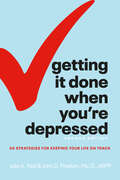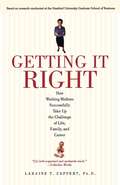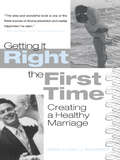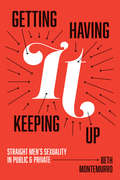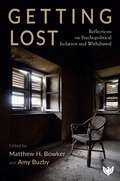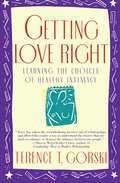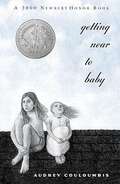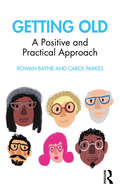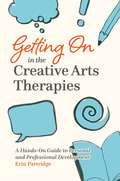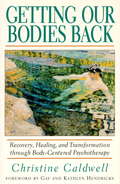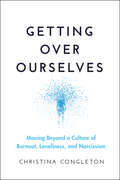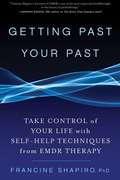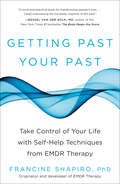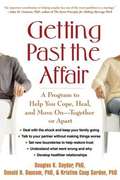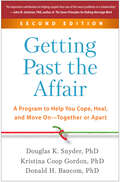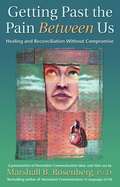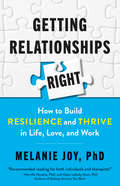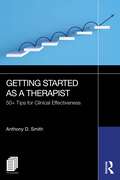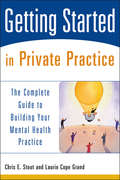- Table View
- List View
Getting It Done When You're Depressed, Second Edition: 50 Strategies for Keeping Your Life on Track
by John Preston Julie A. FastDon't wait another day to live the life you deserve! Instead, get it done while you're depressed.Do you find your energy to be at an all-time low? Do you struggle to get out of bed some days?Have you found yourself losing interest in things that used to excite you?Then this book might be the book for you. Inside the pages of this self-help book, you can find: - Advice on altering your mindset and adopting a more creative approach to life- A step-by-step guide on how to wait until your work is complete before you judge it- Tips and tricks on thinking like an athlete and how this mindset can help change your life- Fundamental strategies for keeping your life on trackMany people experience the hardships of depression and tend to struggle with productivity during these difficult times. Getting It Done When You&’re Depressed is a therapy book that offers you 50 strategies to break the cycle of unproductivity and live a fuller life. Join us in learning how to overcome depression symptoms and take back your livelihood. When facing depression daily, it can be tough to do day-to-day tasks without it seeming like a giant chore. At DK, we believe it&’s time to change that! By implementing strategies to create a daily structure tailored to your individual needs, we believe you can take back control of your mental health and live the life you want. The ground-breaking strategies provided in this wellness book are easy to follow and practical for anyone trying to live a more productive life. At DK, we believe in the power of discovery. So don't let depression limit what you're capable of achieving! It's time to be proud of yourself and your abilities, and discover how to get things done while you are depressed.Fancy a new and improved you this New Year? This must-have health book will help teach you how to be happy, approach life with a fresh perspective, rewire your brain, bring power to your productivity and unleash your potential!
Getting It Right
by ZappertCareer or motherhood? Do you have to sacrifice one to be truly successful in the other? And if you're trying to do both, will you have to compromise your career path or your child's needs? With professional demands increasingly impinging on personal time, is "having it all" even realistic, or is it just plain fantasy? Now leading Stanford University psychologist Dr. Laraine Zappert, who specializes in the issues of women and work, draws upon her twenty years of clinical and research experience and a landmark study to answer these questions and create a road map of innovative solutions. Dr. Zappert surveyed more than three hundred women who have graduated from Stanford's Graduate School of Business, and has incorporated case studies from hundreds of women professionals in each chapter. Her findings address such common concerns as: Do I really have to choose between career and family? How do I handle the stresses of my job and the demands of parenting? How do children affect my career, and when is the best time to have them? How do I keep my relationships healthy? Who will care for my children when I'm not available? Coming from many different occupational backgrounds, the subjects of Dr. Zappert's study show us that although we so often think that everyone else is doing it better and having an easier time of it, that is hardly ever the case. Sometimes "good enough" has to do. And whereas the stresses may be the same for all working women, the solutions rarely are. Let the insights, advice, and strategies found in Getting It Right help you make smarter, more informed decisions for creating a satisfying and fulfilling lifestyle on every level.
Getting It Right the First Time: Creating a Healthy Marriage
by Barry McCarthy Emily J. McCarthyA healthy marriage is the result of much more than a stroke of good fortune, the accidental meeting of two "soul mates," or a conscious commitment to stay together no matter what. Studies have found that romantic, passionate love is often just a memory by the wedding, or within the first year of marriage. Creating an intimate, satisfying, and stable marriage is by no means easy or guaranteed--it requires thought, communication, planning, and true commitment to each other (though luck and compatibility never hurt). The window of opportunity in which to build the foundation for such a relationship is narrow, and does not often last too long after the first two years of a marriage.Getting it Right the First Time provides the information every couple needs to know to understand what really makes a marriage work. Husband and wife team, Barry and Emily McCarthy share clear, helpful guidelines for creating a healthy marriage and reveal the strategies, skills, and attitudes that can help prevent disappointment, resentment, and alienation from entering the relationship. Ask any happily married couple whether the time and effort spent in creating a healthy marriage has been worth it, and you should get a universal answer. Getting it Right the First Time can make getting there a little easier.
Getting It, Having It, Keeping It Up: Straight Men’s Sexuality in Public and Private
by Beth MontemurroScholars and social critics are looking at gender and sexuality, as well as masculinity, in new ways and with more attention to the way cultural ideologies affect men’s and women’s lives. With the rise of an online “incel” (involuntarily celibate) community and the perpetration of acts of violence in their name, as well as increased awareness about the complexities of sexual interaction brought to the fore by the #metoo movement, it has become critical to discuss how men’s sexuality and masculinity are related, as well as the way men feel about the messages they get about being a man. Prior research on masculinity and masculine sexuality has examined the experiences of adolescent boys. But what happens to boys as they become men and as many move away from homo-social environments into sexual relationships? What happens when they no longer have a crowd of peers to posture or perform for? How do their sexual experiences and sexual selves change? How do they prove their masculinity in a society that demands it when they are no longer surrounded by peers? And how do they cultivate sexual selves and sexual self-confidence in a culture that expects them to always already be knowledgeable, desiring sexual subjects? In Getting It, Having It, Keeping It Up, Beth Montemurro explores the cultivation of heterosexual men’s sexual selves. Based on detailed, in-depth interviews with a large, diverse group of heterosexual men between the ages of 20 and 68, she investigates how getting sex, having sex, and keeping up their sex lives matters to men. Ultimately, Montemurro uncovers the tension between public, cultural narratives about hetero-masculinity and men’s private, sexual selves and their intimate experiences.
Getting It: The Psychology of Est
by Sheridan FenwickGetting It: The Psychology of Est by Sheridan Fenwick.
Getting Lost: Reflections on Psychopolitical Isolation and Withdrawal
by Amy Buzby Matthew H BowkerWith contributions from Matthew H. Bowker, Amy Buzby, Jack Fong, Evangelia Galanaki, Jill Gentile, Nathan Gerard, Theofilos Gkinopoulos, Dan Livney, Elliott Schwebachand, and Michael J. Thompson. The prime example or idee clef that unites the chapters of this volume is the experience of the global Covid-19 pandemic from 2019 to 2023, in which we witnessed forms of isolation and withdrawal that meant something more than separation. Withdrawal and isolation work on the self, although they may not do so consciously. Whereas it is possible to be separated from others simply as a matter of fact and from the 'outside,' Getting Lost focuses on complex internal and psychopolitical processes involving retreat or removal of selves from the worlds of politics, society, and culture. When we feel isolated or we withdraw ourselves, something tends to arise in our place: be it a defense system, a constellation of symptoms, or the deeply repressed psychic material giving rise to either or both. Thus, it was not coincidental that, as millions died from Covid, and as millions more experienced severely 'broken sociality' in the Covidian world of risk, quarantine, and/or lockdown, we also found ourselves witnessing explosions of extremism in popular discourse, in large-scale border closures, in encroachments on women's and reproductive rights, in physical attacks on the Capitol Building in Washington, DC, in domestic and spousal violence and youth suicide, in a war of aggression waged by Russia on Ukraine, and much more. We advance the term 'psychopolitical isolation and withdrawal' in order to capture not only temporary periods of isolation but also detachments from reality and perverse attachments to unreality, visible on small and large scales. This partial or perverse facing of our self-experience and shared experience suggests the possibility that the post-Covidian era brings with it altered relationships to both the private and the public home, and, with them, the meanings of citizenship, sociality, publicity, thinking, and being. Plainly put, the impact of Covid-19 worldwide has damaged people's relationship to reality and we are still coming to terms with and uncovering the many ways in which this manifests. This book aims to signal an immediate, existential threat to psychosocial and political life and to inspire further thinking, debate, and work on these vital topics that affect us all.
Getting Love Right: Learning the Choices of Healthy Intimacy
by Terence T. GorskiIT'S NEVER TOO LATE TO LEARN HOW TO LOVEWhen you fall in love you may be repeating bad relationship habits that you learned growing up or in a previous unhealthy relationship. No matter what your history, Getting Love Right can explain how to build and maintain healthy intimacy, including:* How to recognize if you are in a compulsive, apathetic, or healthy relationship* How to become a person who is capable of healthy intimacy* How to choose a healthy partnerIf you are in a relationship or want to be in one, Terence T. Gorski will teach you that love isn't just something that happens -- love is something you can learn.
Getting Medieval: Sexualities and Communities, Pre- and Postmodern
by Carolyn DinshawIn Getting Medieval Carolyn Dinshaw examines communities--dissident and orthodox--in late-fourteenth and early-fifteenth-century England to create a new sense of queer history. Reaching beyond both medieval and queer studies, Dinshaw demonstrates in this challenging work how intellectual inquiry into pre-modern societies can contribute invaluably to current issues in cultural studies. In the process, she makes important connections between past and present cultures that until now have not been realized. In her pursuit of historical analyses that embrace the heterogeneity and indeterminacy of sex and sexuality, Dinshaw examines canonical Middle English texts such as the Canterbury Tales and The Book of Margery Kempe. She examines polemics around the religious dissidents known as the Lollards as well as accounts of prostitutes in London to address questions of how particular sexual practices and identifications were normalized while others were proscribed. By exploring contemporary (mis)appropriations of medieval tropes in texts ranging from Quentin Tarantino's Pulp Fiction to recent Congressional debates on U. S. cultural production, Dinshaw demonstrates how such modern media can serve to reinforce constrictive heteronormative values and deny the multifarious nature of history. Finally, she works with and against the theories of Michel Foucault, Homi K. Bhabha, Roland Barthes, and John Boswell to show how deconstructionist impulses as well as historical perspectives can further an understanding of community in both pre- and postmodern societies. This long-anticipated volume will be indispensible to medieval and queer scholars and will be welcomed by a larger cultural studies audience.
Getting Near to Baby
by Audrey CouloumbisAudrey Couloumbis's masterful debut novel brings to mind Karen Hesse, Katherine Paterson, and Betsy Byars's The Summer of the Swans—it is a story you will never forget. <P><P> Willa Jo and Little Sister are up on the roof at Aunt Patty’s house. Willa Jo went up to watch the sunrise, and Little Sister followed, like she always does. But by mid-morning, they are still up on that roof, and soon it’s clear it wasn’t just the sunrise that brought them there. <P> The trouble is, coming down would mean they’d have to explain, and they just can’t find the words. <P> This is a funny, sometimes heartbreaking, story about sisters, about grief, and about healing. Two girls must come to terms with the death of their baby sister, their mother’s unshakable depression, and the ridiculously controlling aunt who takes them in and means well but just doesn’t understand children. Willa Jo has to try and make things right in their new home, but she and Aunt Patty keep butting heads. Until the morning the two girls climb up to the roof of her house. Aunt Patty tries everything she can think of to get them down, but in the end, the solution is miraculously simple.<P> A Newbery Honor Book<P> An ALA Notable Book<P> A School Library Journal Best Book of the Year<P>
Getting Old: A Positive and Practical Approach
by Rowan Bayne Carol ParkesGetting Old offers concise advice and practical suggestions for all readers interested in or worried about ageing, either in themselves or in someone they care about. With a focus on a positive view of ageing, it discusses central physical and mental aspects of getting old, as well as the social and psychological aspects such as choosing where to live and becoming more oneself. Rowan Bayne and Carol Parkes take a pragmatic approach to reviewing what is happening in many aspects of your life as you age. Essential topics covered include mobility; diet and digestion; understanding and improving sleep; memory problems and dementia; being an active participant in consultations about your own healthcare; attitudes to getting old; romantic relationships and loneliness; deciding where to live, moving house and choosing other types of living arrangements; and death and grief. They invite readers to focus on their own life and experience, to understand who they are and what they really want now. An important part of self-understanding is the application of personality theory to changes associated with getting old, and readers are encouraged to reflect on what might work for people with their personality characteristics, and how to improve their stress management, communication and decision making. With suggestions for further reading and useful organisations that offer support, Getting Old offers valuable, affirming guidance for all those and their relatives going through this life stage, as well as health, social care and counselling students and professionals.
Getting On in the Creative Arts Therapies: A Hands-On Guide to Personal and Professional Development
by Erin PartridgeWhat do you really want from your career, and how are you going to get it? How do you find the right people and make the right connections along the way? What are the secrets of finding fulfilment in your work? This book is intended to help you to answer these questions - and many more. Written to inspire and motivate you as you progress through your career as creative arts therapist, it shares diverse stories and experiences spanning different career paths and decisions. The book also tackles common early career challenges including designing services, advocacy and collaborative working, exploring how adverse circumstances can be used as opportunities for growth. With creative and reflective exercises throughout to help you to identify your goals and achieve them, this book is an indispensable guide for any creative arts therapist who wants to flourish in their career.
Getting Our Bodies Back
by Christine CaldwellA habitual movement as common as nail-biting or toe-tapping can be the key to pulling out addictive behavior by its roots. These unconscious movement "tags" indicate the places where our bodies have become split off from our psyches. When brought to consciousness and confronted they will often tell us very plainly where our psychological suffering originated, showing us where to begin reconnecting body and soul. Christine Caldwell, a pioneer in the field of somatic psychology, has created an original model for working with body wisdom called the Moving Cycle. She describes how this form of therapy has worked effectively in her own practice, and she provides practical techniques to show how we can learn to listen to what our bodies are telling us, confront addictive habits, and learn to celebrate our inherent wisdom and elegance.
Getting Over Getting Mad: Positive Ways to Manage Anger in Your Most Important Relationships
by Judy FordWith society increasingly held hostage to stress, conflict, and violence, the issue of anger is getting lots of attention. Couples, families, schools, and workplaces are all focusing attention on anger and how to effectively deal with it. In contrast to books that analyze the causes of anger or discuss the issue on a societal level, Getting Over Getting Mad provides us with inspiration and suggestions for making positive changes in ourselves and our relationships. The book's primary emphasis is on prevention, encouraging us to deal with stress, frustration, tantrums, and annoyances quickly, before these disturbances sour feelings and burn bridges. The book also gives concrete suggestions for handling anger in ongoing difficult situations, and chronicles the author's own experiences as a therapist and workshop leader.
Getting Over Max Cooper
by Marcelle KarpLetting go is a beach.Jazz Jacobson has spent fourteen of her sixteen summers on Fire Island. It's just an hour from Manhattan but feels like a world away, where Jazz thrives in the absence of the social hierarchies and pressures of high school. Most of all, it's the place where she's reunited with her best friend, Macy Whelan. This summer starts out strong when the cute new boy on the island seems to like Jazz (hello, first boyfriend?). But it's hard to focus on her own crush when Macy's still obsessing over her hookup from last summer, Max Cooper. Jazz can't believe how cold and mean Max is to Macy. But when Macy starts to seriously act out, Jazz begins to see that she knows only one side of the story . . . and that she has to help her friend before something terrible happens. Boundaries are crossed and the edge of sanity is tested in Marcelle Karp's debut novel, which celebrates the complicated dynamics of female friendship and the heartbreaking ache of first love.
Getting Over Ourselves: Moving Beyond a Culture of Burnout, Loneliness, and Narcissism
by Christina CongletonMove beyond empty “life hacks” to connect with your deepest humanity In Getting Over Ourselves: Moving Beyond a Culture of Burnout, Loneliness, and Narcissism, human development specialist and leadership coach Christina Congleton delivers an insightful and urgently needed discussion of how people can break out of the tired cliches of the self-help genre, and move toward new levels of connection, engagement, and capacity in navigating an uncertain world. In the book, you'll explore how modern attitudes of individualism that were once freeing now converge with environmental destruction, inequality, and an alarming uptick in depression, substance abuse, and suicide to significantly damage the potential of people everywhere. You'll also find concrete strategies—rooted in developmental psychology—that show us new ways to approach these challenging times. Getting Over Ourselves offers: Insights into why “life hacks,” productivity seminars, and more “adulting” are not the solutions to the issues faced by people today Frameworks that reject the idea that there is a separate, solitary self in need of constant improvement, and connect you with your deepest humanity Effective techniques for fending off burnout and ways to move beyond the unsatisfactory status quo An essential and timely work, Getting Over Ourselves is the antidote to the skin-deep, ineffective “self-help” material that you've been looking for.
Getting Past Your Breakup: How to Turn a Devastating Loss into the Best Thing That Ever Happened to You
by Elliott Susan J.From the creator of the Getting Past Your Past blog, a tough-love method for making life after a breakup an empowering experience
Getting Past Your Past: Take Control of Your Life with Self-Help Techniques from EMDR Therapy
by Francine ShapiroIn this book, Shapiro, the creator of EMDR (Eye Movement Desensitization and Reprocessing), explains how our personalities develop and why we become trapped into feeling, believing and acting in ways that don't serve us. Through detailed examples and exercises readers will learn to understand themselves, and why the people in their lives act the way they do. Most importantly, readers will also learn techniques to improve their relationships, break through emotional barriers, overcome limitations and excel in ways taught to Olympic athletes, successful executives and performers.
Getting Past Your Past: Take Control of Your Life with Self-Help Techniques from EMDR Therapy
by Francine ShapiroA totally accessible user's guide from the creator of a scientifically proven form of psychotherapy that has successfully treated millions of people worldwide.Whether we've experienced small setbacks or major traumas, we are all influenced by memories and experiences we may not remember or don't fully understand. Getting Past Your Past offers practical procedures that demystify the human condition and empower readers looking to achieve real change.Shapiro, the creator of EMDR (Eye Movement Desensitization and Reprocessing), explains how our personalities develop and why we become trapped into feeling, believing and acting in ways that don't serve us. Through detailed examples and exercises readers will learn to understand themselves, and why the people in their lives act the way they do. Most importantly, readers will also learn techniques to improve their relationships, break through emotional barriers, overcome limitations and excel in ways taught to Olympic athletes, successful executives and performers. An easy conversational style, humor and fascinating real life stories make it simple to understand the brain science, why we get stuck in various ways and what to do about it. Don't let yourself be run by unconscious and automatic reactions. Read the reviews below from award winners, researchers, academics and best selling authors to learn how to take control of your life.
Getting Past the Affair
by Donald Baucom Douglas SnyderDiscovering that a partner has been unfaithful hits you like an earthquake. Long after the first jolt, emotional aftershocks can make it difficult to be there for your family, manage your daily life, and think clearly about your options. Whether you want to end the relationship or piece things back together, Getting Past the Affair guides you through the initial trauma so you can understand what happened and why before deciding how to move forward. Based on the only program that's been tested--and proven--to relieve destructive emotions in the wake of infidelity, this compassionate book offers support and expert advice from a team of award-winning couple therapists. If you stay with your spouse, you'll find realistic tips for rebuilding your marriage and restoring trust. But no matter which path you choose, you'll discover effective ways to recover personally, avoid lasting scars, and pursue healthier relationships in the future.
Getting Past the Affair: A Program to Help You Cope, Heal, and Move On--Together or Apart
by Douglas K. Snyder Donald H. Baucom Kristina Coop Gordon"How could my partner have done this?" "What was my role?" "Can this relationship be saved?" Discovering that your partner has had an affair can feel like an earthquake. Long after the first jolt, the emotional aftershocks can make it hard to be there for your family, go about your daily business, and think clearly about your options. Where can you turn for help? From award-winning couple therapists, this compassionate guide has already provided support and expert advice to tens of thousands of readers. Updated throughout, the second edition confronts the myriad challenges facing couples today. Drawing on the latest research, the authors share vivid stories of diverse partners struggling with infidelity in all its forms--sexual or emotional, in-person or online. Learn how to process what happened, cope with anger and mistrust, and map a way to move forward, whether separately or together.
Getting Past the Pain Between Us: Healing and Reconciliation Without Compromise
by Marshall B. RosenbergSkills for resolving conflicts, healing old wounds, and reconciling strained relationships reveal the healing power of listening and speaking from the heart. The tenets of 'Non-Violent Communication' are applied to a variety of settings, including the classroom and the home, in these booklets on how to resolve conflict peacefully. Illustrative exercises, sample stories, and role-playing activities offer the opportunity for self-evaluation, discovery, and application.
Getting Relationships Right: How to Build Resilience and Thrive in Life, Love, and Work
by Melanie JoyBestselling author, psychologist, and relationship coach Melanie Joy shares the principles and tools that can make any relationship, from personal to professional, healthier and more resilient.Relationships are complicated. Yet it's an unfortunate reality that while most of us have to learn complex geometry that we'll probably never use, we don't get a single formal lesson in how to relate to others. In this one-stop guide, psychologist Melanie Joy reveals the common psychological dynamics that underlie all kinds of relationships—with a romantic partner, friends, family members, colleagues—in short, with anyone in any situation. Understanding these dynamics will help you make all your relationships healthier and more resilient. Relationships are like bodies: they get sick when their immune system is weaker than the germs that stress them. Drawing on the most relevant research as well as on her own extensive experience as a psychologist, Joy explains how to strengthen your relational immune system to resist not only interpersonal stressors but also largely invisible yet potentially devastating societal stressors like racism and sexism. With this understanding, you can cultivate relationships that consistently reflect core moral values and honor the dignity of everyone involved. Resilient relationships are not only a source of joy and fulfillment for those who are in them, they also support the thriving of the organizations and communities of which we all are a part.
Getting Started as a Therapist: 50+ Tips for Clinical Effectiveness
by Anthony D. SmithGetting Started as a Therapist provides students and new therapists with a bridge between education and practice. Written for a transtheoretical audience, the book explores questions and struggles common to students and new therapist supervisees. Readers can find pointed guidance in 52 chapters, spanning five categories. Categories include: Establishing better therapeutic relationships. What to avoid saying to patients. Increasing diagnostic accuracy, understanding why diagnosis is not a dirty word, and how it is critical to a good outcome. Specialized topics like how to more effectively talk about self‑injury and learning to use metaphors. Professional development such as making the most of supervision and how to limit liability. The succinct chapters come alive with real‑life examples and are often followed by suggestions for further reading and worksheets that help readers to refine their practice.
Getting Started in Personal and Executive Coaching
by Stout Fairley Stephen G. Chris E.Find satisfaction and financial success with a new career in coaching Getting Started in Personal and Executive Coaching offers a go-to reference designed to help every mental health professional build, manage, and sustain a thriving coaching practice. Packed with hundreds of proven strategies and techniques, this nuts-and-bolts guide covers all aspects of the coaching business with step-by-step instructions and real-world illustrations that prepare you for every phase of starting your own coaching business. This single, reliable book offers straightforward advice and tools for running a successful practice, including: * Seven tools for making a great first impression * Fifteen strategies for landing ten paying clients * Seven secrets of highly successful coaches * Ten marketing mistakes to avoid Complete with sample business and marketing plans and worksheets for setting rates and managing revenue, Getting Started in Personal and Executive Coaching identifies the fifteen biggest moneymaking markets to target and offers valuable recommendations for financing that get the most impact and mileage from every budget. Quick "Action Steps" for applying ideas and techniques make this book useful right away. Get started in coaching today!
Getting Started in Private Practice
by Stout Chris E. Grand Laurie C.All the tips and tools you need to build a successful mental health practice from the ground up Many mental health professionals currently working for group practices, hospitals, and private or government agencies have both the skills and the drive to become solo practitioners. But how and where do you begin? Getting Started in Private Practice is a reliable reference that offers the comprehensive information and armchair motivation you need to establish and build your own practice from the ground up. User-friendly and full of helpful tips, this handy book provides you with tools and techniques for starting and maintaining a thriving private practice, including information on: * Discovering your ideal practice * Creating a business plan * Financing your start-up * Setting fees * Setting up shop and measuring results * Minimizing risk * Managing managed care * Marketing your practice * Generating referrals * Utilizing additional print, Web, and organizational resources From major concerns such as ethics and liability to day-to-day matters like selecting stationery and business cards, Getting Started in Private Practice puts the best solutions at your fingertips. Whether you're a recent graduate or a seasoned pro, this invaluable resource will help you minimize the uncertainty of establishing a solo practice while maximizing the rewards.
